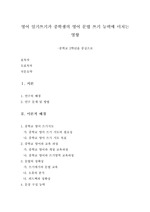· 박혜숙, 영어 쓰기 교육의 이해, 서울: 한국문화사, (2006).
· 최연희, 영어 쓰기 교육론 : 원리와 적용, 서울 :한국문화사,(2007.
· <학술지/논문>
· 강순희, "영어 일기를 활용한 쓰기 능력 지도 방안". 공주대학교대학원 석사학위논문, (2004).
· 고경순, 「과제중심 초등학교 영어 쓰기 지도 방안에 관한 연구」, 한국교원대 교육대학원 석사학위 논문, (2007).
· 고원태, "영어 일기 쓰기가 영어 어휘력 신장 및 영어 읽기 능력에 미치는 영향", 부산교육대학교 교육대학원 석사학위논문, (2006).
· 구귀련, "영어 일기 쓰기 활동이 초등학생들의 영어 쓰기 능력에 미치는 영향", 진주교육대학교 석사학위논문, (2003).
· 김다혜, "영어 일기 쓰기를 활용한 초등 영어 쓰기 지도의 효과연구", 경인교육대학교 석사학위논문, (2006).
· 김진철 박기화, “초등영어 교육 실시 효과에 관한 연구”, 초등영어교육, Vol.5 No.2, (1999).
· 김현진, "중학교 영어교육 수업실습에 관한 영어교사, 교육실습생 및 학습자의 인식 비교 연구", 한국외국어대학교 교육대학원,(2008).
· 남궁선, "영어 일기 쓰기가 전반적 쓰기 능력에 미치는 영향-초등학교 6학년 학습자를 중심으로", 공주교육대학원 석사학위논문, (2005).
· 민찬규, “영어교육과 쓰기교육”, 영어교육, Vol.- No.48,(1994).
· 박명순, "영어 일기 쓰기 활동이 초등 학습자의 쓰기 능력에 미치는 영향", 광주교육대학교 교육대학원 석사학위논문, (2007).
· 박혜숙, 문법지도가 제2언어습득에 미치는 영향, 영어교육, 53(1), 157~174, (1998).
· 배미희, "사이버 영어 일기 쓰기가 영어 쓰기 흥미도 및 어휘력신장에 미치는 영향". 부산교육대학교 대학원 석사학위 논문, (2001).
· 서진아, “초등 영어 학습자의 영작문 오류 분석“, 서울교육대학교 교육대학원, (2003).
· 이동한, 초등학교 영어 지도서에 제시된 교사의 scaffolding 발문 유형 분석, 영어교육연구, 16(3), 239~256, (2004).
· 양만섭 손영귀, “중등학교 영어쓰기교육의 실태분석”, 영어교육연구, Vol.- No.38, (2009).
· 이미정, “오류분석을 통한 초등학교 영어 교과서의 언어 구조 제시 방안”, 인천교육대학교 교육대학원, (2002).
· 이정옥, "절차를 달리한 영어 일기 쓰기의 효과에 대한 연구-초등학교 5, 6학년을 대상으로", 서울시립대 대학원 석사학위 논문, (2005).
· 이의갑,"고등학교 영어과 선택교육과정 과목 개설에 관한 설문조사 연구", Foreign languages education, Vol.13 No.4, (2006).
· 이혜련, “영어 학습자 중간언어의 오류에 관한 연구”, 한국교원대학교, (1996).
· 지현아, “영어일기를 활용한 쓰기지도 방안연구”, 명지대학교 교육대학원, (2007).
· 정길정, 민찬규, “제7차 교육과정에 따른 성취기준 및 평가기준 개발연구: 고등학교 공통영어 문자 언어를 중심으로. 영어교육연구“, 16(1), 223-255, (2004).
· 최원숙, “교정 피드백이 과거동사 사용의 정확성 향상에 미치는 영향 : 초등학생 영어일기 쓰기 지도를 중심으로” , 계명대학교 교육대학원, (2011).
· Arabski, J., "Errors as indications of the development of interlanguage", Katowice : universytet Slaski, (1979).
· Ashwell, T., Patterns of teacher response to student writing in a multi-draft composition classroom: Is content feedback followed by form feedback the best method? Journal of Second Language Writing, 9 (3), 227-257, (2000).
· Bitchener, J., & Knoch, U. (2008). The value of written corrective feedback for migrant and international students. Language Teaching Research Journal 12(3), 409-431.
· Brown, H. D., "Principles of language learning and teaching", NY: Addison Wesley Longman, (1993).
· Byrne, D., "Teaching writing skills", Harlow : Longman, (1988).
· Casanave, C. (2004). Contrastive rhetoric. In C. Casanave (Ed.), Controversies in Second Language Writing: Dilemmas and Decisions in Research and Instruction (pp. 26-62). Ann Arbor: University of Michigan Press.
· Chandler, D. (2003) ‘Bosnia: Profile of a Nato Protectorate’, in T. Ali (ed), Masters of the Universey : Nato’s Balkan Adventure (London: Verso), 271284.
· Chandler, J. (2003). The efficacy of various kinds of error feedback for improvement in the accuracy and fluency f L2 student writing. Journal of Second Language Writing, 12, 267296.
· Cumming, A. (1989). Writing Expertise and Second Language Proficiency. Language Learning. 39 (1): 81-141.
· Ellis, R., A typology of corrective feedback types. ELT Journal, 63 (2), 97-107, (2009)..
· Etheron, "The effects of halothane and ether on the pulmonary circulation in the innervated perfused cat lung", Endocr Res Commun. ;4(3-4):183-93.(1977).
· Fathman, A.K., & Whalley, E., "Teacher response to student writing: Focus on form versus content. In B. Kroll (Ed.)", Second language writing (pp. 178-190). Cambridge: Cambridge University Press, (1990).
· Fathman, A., & Whalley, E. Teacher response to student writing: Focus on form versus content. In B. Kroll(Ed.), Second language writing: Research insights for the classroom (pp.178-190), Cambridge: Cambridge University Press, (1990).
· Ferris, D. R. & Roberts, B. Error feedback in L2 writing classes: How explicit does it need to be? Journal of Second Language Writing, 10 (3), 161-184, (2001).
· Harmer. J., "How to Teach English: an introdution to the practice of English Language Teaching", harlow : longman, (1998).
· Hedge. T., " Teaching and learning in the language classroom", New York : Oxford Univetsitiy Press, (2005).
· Holmes, V.L., & Moulton, M.R. (1995). A Contrarian view of dialogue journals: The case of a reluctant participant. Journal of Second Language Writing, 4(3), 23-251.
· Hyland, F., Focusing on form: Student engagement with teacher feedback. System, 31 (2), 217-230, (2003).
· Kroll, J. F., Michael, E., Tokowicz, N., & Dufour, R. (2001). The development of lexical fluency in a second language. Second Language Research, 18, 137-171.
· Leki, I. 1990. Coaching from the margins: Issues in written response. In Second Language Writing. ed. B. Kroll. New York: Cambridge University Press.
· Olshtain. E., " Discourse and context in language Teaching", (1991).
· Raimes, A., Techniques in Teaching Writing", New York : Oxford Univetsitiy Press, (1983).
· Rivers, W. M., “Teaching Foreign Language Skills(2nd ed.) Chicago, IL: The Chicago University Press, (1981).
· Selinker, L., "Interlanguage. International Review of Applied Linguistics", 10 (3), 209-231. (1972).
· Sherman, P.W. 2004. Levels of analysis in behavior (pages 723-725), Naked mole-rats (pages 775-776), and Morning sickness (pages 916-918) in Encyclopedia of Animal Behavior. M. Beckoff (Ed.). Greenwood Press.
· Scott, M. S. and Tucker, G.R., (1974), Error analysis and english language stategies of arab students", Language Learning, 24/1:69-79.
· White, R. and Arndt, V., "Process Writing". London: Longman, (1991).
· Zamel, V.. “Writing: The process of discovering meaning”. TESOL Quarterly, 16, 195-209, (1988).

